|
Talos Dome is an ice dome on the edge of the East Antarctic plateau, about 290 km from the Southern Ocean, 250 km from the Ross Sea, 275 km from the Italian Station
(Mario Zucchelli Station), 550 km North of Taylor Dome, 1500 km NW of Siple Dome, and 1100 km East of Dome C
(Frezzotti et al., 2004).
In order to provide detailed information on the temporal and spatial variability of snow accumulation, research was conducted at Talos Dome and along
a north-south transect, within the framework of the ITASE (International TransAntarctic Scientific Expedition) program
(Mayewski et al., 2005).
Oversnow traverses were conducted
in 1996 (Terra Nova Bay-Talos Dome:
Frezzotti & Flora, 2001;
Stenni et al., 2001),
1998-99 (Terra Nova Bay-Dome C;
Frezzotti et al., 2005;
Proposito et al., 2002)
and 2001-02 (Wilkes Land-Victoria Land;
Becagli et al., 2004;
Magand et al., 2004;
Frezzotti et al., 2007).
The north-western drainage area of Talos Dome base is mostly below sea level (Wilkes Subglacial Basin). For this
reason, this drainage area is more sensitive to climatic and eustatic fluctuations than other sectors of the East Antarctic Ice Sheet
(Frezzotti et al., 2004).
The radio echo-sounding result indicates that the bedrock of the Talos Dome summit (TDS 159°04'21"E, 72°47'14"S, 2318.5 m) is at about 440 m in elevation, and that it
is covered by about 1880 m of ice. The dome summit is situated above a slope bedrock and internal layering. A relatively flat bedrock was identified at 5-6 km from
summit along the SE ice divide (ID1), where the bedrock is about 770 m in elevation and covered by 1600 of ice. At ID1, internal layering is continuous and
horizontal with divergent flow, and at dome summit internal layers follow the slope of bedrock topography
(Urbini et al., 2006).
The ID1 site (159°11' E 72°49'S 2315 m) was chosen as the drilling site for the TALDICE project.
GPS survey indicates that the TALDICE site (ID1) moves at about 0.14 m yr-1 versus the SE ice divide.
Drilling at Talos Dome began in 1996, with the retrieval of 89 m deep, 10 cm diameter cores (TD). High-resolution chemical and isotopical measurements on the
TD core confirmed the potential for obtaining interpretable geochemical records from Talos Dome
(Stenni et al., 2001;
Becagli et al., 2004;
Traversi et al., 2004).
Deep drilling (http://www.dt.insu.cnrs.fr/carottier/carottier.php),
using the the 200-m LGGE drill system during the first year and than Berkner Island system in follow years (from 128 to 1620 m), started during the 2004-05 austral summer season
and successfully reached a depth of 1620 metres during the 2007-08 season. The drill was deeper than expected because the drill missed (for less than 200 m)
the intended target area over a plateau in the bedrock, instead drilling into the ice that filled an unsurveyed deep gorge (1.6 km wide) where the ice thickness
is about 1795 m (Corr BAS pers com). Presurvey radio-echo sounding did not provide a detailed topographical survey of the bedrock, in part due to poor directivity
of the antenna system.
The measured temperature was -41 °C at a depth of 15 m, which closely approximates the mean annual "surface temperature" in dry snow and the mean annual "screen air
temperature". Katabatic wind blows mainly from the SSW in the windward area and change direction (South, SSW and ESE) at the ice divide and in the downwind area.
An average accumulation rate of 80 kg m-2 yr-1 over the last eight centuries was reconstructed at the 1996 core site (TD), using seasonal
variations in nss SO42- concentrations coupled with the identification of tritium marker levels (1965-66) and nss SO42-
spikes from key past volcanic events (Stenni et al., 2001).
The ice density value of 830 kg m-3 (close-off) was measured at about 72 m depth in the TALDICE core.
Geological reconstructions of the closer mountain area (40-70 km far) indicate that the Talos Dome was not overrun by East Antarctic ice during the Last Glacial
Maximum, and that modest thickening probably occurred (100-200 m). This modest thickening of the northern Rennick Glacier (100-200 m) with respect to the unchanged
elevation of the southern glaciers (Priestley Glacier and Reeves Glacier) suggests that the dome summit migrated southward during the Last Glacial Maximum
(Frezzotti et al., 2004).
The Talos Dome palaeo-accumulation distribution over the last few centuries shows a decrease in the accumulation gradient along the wind direction. As a result
of the changed accumulation conditions, the Talos Dome summit has probably migrated a few metres per year in recent centuries, with a decrease in velocity in
the NE portion and an increase (on the order of some mm yr-2) in the SW portion
(Urbini et al., 2008).
|
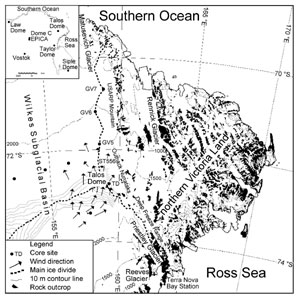
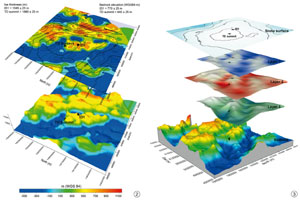
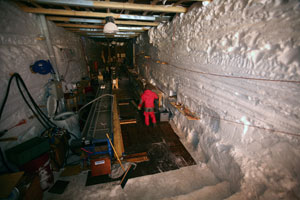
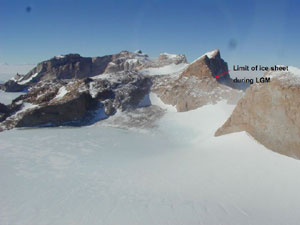
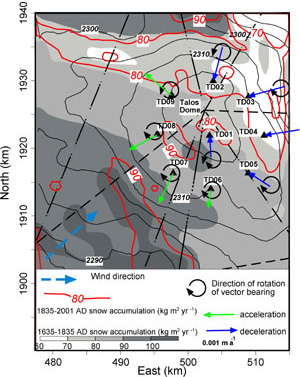
|